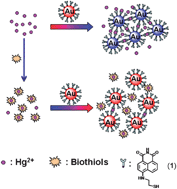Hg2+-mediated aggregation of gold nanoparticles for colorimetric screening of biothiols†
Abstract
In this work, we report a colorimetric assay for the screening of biothiols including

* Corresponding authors
a
Shanghai Key Laboratory of Functional Materials Chemistry, Department of Chemistry, East China University of Science and Technology, Shanghai, PR China
E-mail:
zhongxh@ecust.edu.cn
Fax: +86 21 6425 0281
In this work, we report a colorimetric assay for the screening of biothiols including

 Please wait while we load your content...
Something went wrong. Try again?
Please wait while we load your content...
Something went wrong. Try again?
H. Xu, Y. Wang, X. Huang, Y. Li, H. Zhang and X. Zhong, Analyst, 2012, 137, 924 DOI: 10.1039/C2AN15926K
To request permission to reproduce material from this article, please go to the Copyright Clearance Center request page.
If you are an author contributing to an RSC publication, you do not need to request permission provided correct acknowledgement is given.
If you are the author of this article, you do not need to request permission to reproduce figures and diagrams provided correct acknowledgement is given. If you want to reproduce the whole article in a third-party publication (excluding your thesis/dissertation for which permission is not required) please go to the Copyright Clearance Center request page.
Read more about how to correctly acknowledge RSC content.
 Fetching data from CrossRef.
Fetching data from CrossRef.
This may take some time to load.
Loading related content
